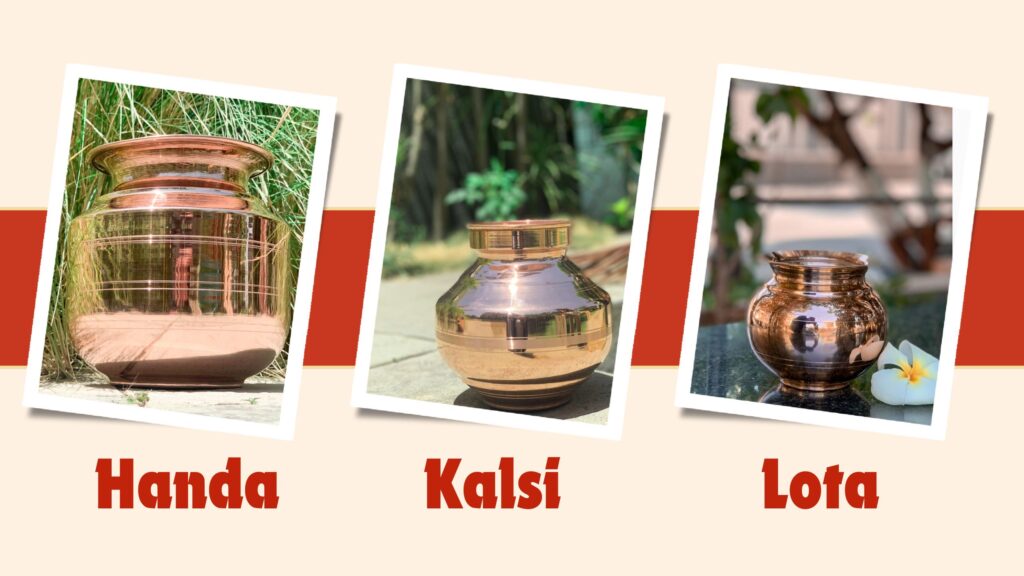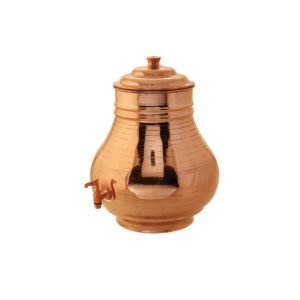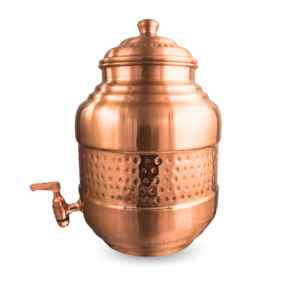
In many traditional Indian households, certain utensils are cherished not just for their utility but also for their cultural significance. Among these, the Handa, Kalsi, and Lota stand out. These timeless items, often crafted from copper, have a rich history and remain essential in many homes today. Let’s explore the origins, uses, and materials of these fascinating utensils, and understand why copper versions are especially prized.
The Handa, also known as a water pot, has been a staple in Indian culture for centuries. Designed for storing and pouring large quantities of water, the Handa plays a crucial role in a country where water storage is essential due to diverse climates. Its history is deeply intertwined with traditional Indian practices, where water holds a sacred place and is integral to numerous rituals.
The primary use of a Handa is to store large quantities of water. In rural areas, Handas are often seen at wells, drawing and storing water for daily use. In the kitchen, Handas serve as reliable storage for drinking water. Additionally, during religious ceremonies, Handas are used to hold holy water, which is sprinkled as a blessing.
Traditionally, Handas have been made from various materials, including brass, clay, and copper. Copper, however, is especially favored for its health benefits. It has antimicrobial properties that purify the water stored in it, making it safer to drink.
At Chirag Pure Copper, we offer a variety of Handas to suit your needs: Navrang Handa, Apple Handa, and Madras Handa.
Why Choose a Copper Handa?
Copper Handas are preferred for their health benefits. The copper ions that dissolve into the water can help improve digestion and reduce inflammation. Storing water in a copper Handa overnight and drinking it in the morning is a practice endorsed by Ayurveda, an ancient Indian system of medicine.
The Kalsi, or water container, is another essential utensil in Indian households. Its history dates back to ancient times when it was used in both domestic and religious contexts. While the shape and design of the Kalsi have evolved, its primary function remains unchanged.
Kalsis are mainly used in traditional Indian rituals and poojas. They hold holy water or other sacred substances required for various ceremonies. While they can also store smaller quantities of water in households, their main role is in ritualistic contexts.
Kalsis come in various materials, including clay, stainless steel, and copper. Each material offers unique benefits, but copper Kalsis stand out for their ability to keep water cool and their antimicrobial properties.
We provide different types of Kalsis: Navrang Kalsi, Apple Kalsi, Poona Kalsi, and Bombay Kalsi.
Why Choose a Copper Kalsi?
Copper Kalsis are highly valued for their health benefits. The antimicrobial properties of copper help reduce the risk of waterborne diseases. Additionally, copper can enhance the taste of water, making it more refreshing to drink. The polished aesthetic of a copper Kalsi also adds charm, making it a popular choice for both functional and decorative purposes.
The Lota, or water pitcher, is perhaps the most iconic of the three utensils. Its spherical shape with a narrow neck has remained largely unchanged for centuries. The Lota’s design is so effective that it has been adopted in various cultures worldwide.
The Lota is a versatile utensil with multiple uses. In Indian households, it is commonly used for drinking water. It is also used in religious rituals to hold holy water or other sacred substances. In rural areas, Lotas are often used for bathing and personal hygiene due to their convenient shape and size.
Lotis are made from different materials, including brass, stainless steel, and copper. The choice of material often depends on the intended use and the cultural significance attached to the utensil.
Our range includes various types of Lotas: Navrang Lota, Apple Lota, Chembu Lota, and Sangli Lota.
Why Choose a Copper Lota?
Copper Lotas are prized for their health benefits and durability. The antimicrobial properties of copper help maintain the purity of the water stored in it. Furthermore, using a copper Lota in daily rituals is believed to bring health benefits, as the water acquires healing properties. The durability and timeless appeal of copper also make it a preferred choice for Lotas.
Copper utensils have been part of Indian culture for centuries, and their benefits are well-documented in ancient texts like Ayurveda. The antimicrobial properties of copper make it an ideal material for water storage, ensuring the water remains free from harmful bacteria and viruses. Additionally, copper-infused water offers several health benefits, including improved digestion, enhanced immunity, and better skin health.
At Chirag Pure Copper, we take pride in preserving this ancient tradition by offering high-quality copper Handas, Kalsis, and Lotas. Our products are crafted with precision, ensuring that you receive the best in terms of both utility and health benefits. Explore our collection of copper utensils here and experience the timeless benefits of copper in your daily life.
The Handa, Kalsi, and Lota are more than just utensils; they are an integral part of Indian heritage and tradition. Their continued use in modern households is a testament to their utility and cultural significance. Copper versions of these utensils, in particular, offer numerous health benefits, making them a valuable addition to any home. By choosing copper Handas, Kalsis, and Lotas, you are not only embracing a piece of history but also ensuring a healthier lifestyle for you and your family.
Visit Chirag Pure Copper to explore our range of copper Handas, Kalsis, and Lotas and bring home the goodness of tradition and health.


